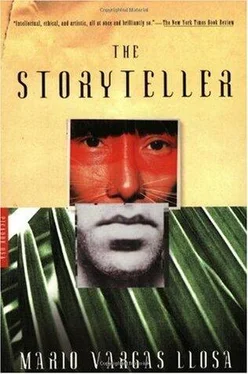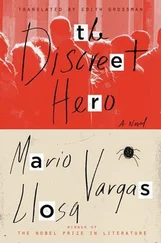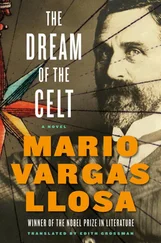Mario Vargas Llosa
The Storyteller
TO LUIS LLOSA URETA,
IN HIS SILENCE,
AND TO THE MACHIGUENGA
kenkitsatatsirira

I came to Firenze to forget Peru and the Peruvians for a while, and suddenly my unfortunate country forced itself upon me this morning in the most unexpected way. I had visited Dante’s restored house, the little Church of San Martino del Véscovo, and the lane where, so legend has it, he first saw Beatrice, when, in the little Via Santa Margherita, a window display stopped me short: bows, arrows, a carved oar, a pot with a geometric design, a mannequin bundled into a wild cotton cushma. But it was three or four photographs that suddenly brought back to me the flavor of the Peruvian jungle. The wide rivers, the enormous trees, the fragile canoes, the frail huts raised up on pilings, and the knots of men and women, naked to the waist and daubed with paint, looking at me unblinkingly from the glossy prints.
Naturally, I went in. With a strange shiver and the presentiment that I was doing something foolish, that mere curiosity was going to jeopardize in some way my well-conceived and, up until then, well-executed plan — to read Dante and Machiavelli and look at Renaissance paintings for a couple of months in absolute solitude — and precipitate one of those personal upheavals that periodically make chaos of my life. But, naturally, I went in.
The gallery was minute. A single low-ceilinged room in which, to make room for all the photographs, two panels had been added, every inch of them covered with pictures. A thin girl in glasses, sitting behind a small table, looked up at me. Could I visit the “Natives of the Amazon Forest” exhibition?
“Certo. Avanti, avanti.”
There were no artifacts inside the gallery, only photos, fifty at least, most of them fairly large. There were no captions, but someone, perhaps the photographer himself, one Gabriele Malfatti, had written a few pages indicating that the photos had been taken during a two-week journey in the Amazon region of the departments of Cusco and Madre de Dios in eastern Peru. The artist’s intention had been to describe, “without demagoguery or aestheticism,” the daily life of a tribe which, until a few years ago, had lived virtually isolated from civilization, scattered about in units of one or two families. Only in our day had they begun to group together in those places documented by the exhibition, but many of them still remained in the forest. The name of the tribe was Hispanicized without spelling errors: the Machiguengas.
The photos were a quite faithful reflection of Malfatti’s intention. There were the Machiguengas, aiming a harpoon from the bank of a river, or, half concealed in the undergrowth, drawing a bow in pursuit of capybaras or peccaries; there they were, gathering cassava in the tiny plots scattered around their brand-new villages, perhaps the first in their long history, clearing the forest with machetes, weaving palm leaves to roof their huts. A group of women sat lacing mats and baskets; another was making headdresses, hooking brightly colored parrot and macaw feathers into wooden circlets. There they were, decorating their faces and bodies in intricate designs with dye from the annatto tree, lighting fires, drying hides and skins, fermenting cassava for masato beer in canoe-shaped receptacles. The photos eloquently showed how few of them there were in the immensity of sky, water, and vegetation that surrounded them, how fragile and frugal their life was; their isolation, their archaic ways, their helplessness. It was true: neither demagoguery nor aestheticism.
What I am about to say is not an invention after the fact, nor yet a false memory. I am quite sure I moved from one photograph to the next with an emotion that at a certain moment turned to anxiety. What’s happening to you? What might you come across in these pictures that would justify such anxiety?
From the very first photos I had recognized the clearings where Nueva Luz and Nuevo Mundo had been built — I had been in both less than three years before — and an overall view of the second of these had immediately brought back to my mind the feeling of impending catastrophe with which I lived through the acrobatic landing that morning as the Cessna belonging to the Institute of Linguistics avoided Machiguenga children. I even seemed to recognize some of the faces of the men and women with whom I had spoken, with Mr. Schneil’s help. This became certainty when, in another photograph, I saw, with the same little bloated belly and the same bright eyes my memory had preserved, the boy whose mouth and nose had been eaten away by uta ulcers. He revealed to the camera, with the same innocence and unselfconsciousness with which he had shown it to us, that hole with teeth, palate, and tonsils which gave him the appearance of some mysterious wild beast.
The photograph I was hoping to see from the moment I entered the gallery was among the last. From the very first glance it was evident that the gathering of men and women, sitting in a circle in the Amazonian way — similar to the Oriental: legs crossed tailor-fashion, back held very straight — and bathed in the light of dusk fading to dark, was hypnotically attentive. They were absolutely still. All the faces were turned, like radii of a circumference, toward the central point: the silhouette of a man at the heart of that circle of Machiguengas drawn to him as to a magnet, standing there speaking and gesticulating. I felt a cold shiver down my spine. I thought: “How did that Malfatti get them to allow him to…How did he manage to…?” I stooped, brought my face up very close to the photograph. I kept looking at it, smelling it, piercing it with my eyes and imagination, until I noticed that the girl in charge of the gallery had risen from her table and was coming toward me in alarm.
Making an effort to contain my excitement, I asked if the photographs were for sale. No, she didn’t think so. They belonged to Rizzoli, the publishers. Apparently they were going to appear in a book. I asked her to put me in touch with the photographer. No, that wouldn’t be possible, unfortunately: “Il signore Gabriele Malfatti è morto.”
Dead? Yes. Of a fever. A virus he’d caught in the jungle, forse. Poor man! He was a fashion photographer: he’d worked for Vogue and Uomo , that sort of magazine, photographing models, furniture, jewelry, clothes. He’d spent his life dreaming of doing something different, more personal, such as taking this trip to the Amazon. And when at last he was able to do so, and they were just about to publish a book with his work, he died! And now, le dispiaceva, but it was l’ora di pranzo and she had to close.
I thanked her. Before leaving to confront once again the wonders and the hordes of tourists of Firenze, I managed to cast one last glance at the photograph. Yes. No doubt whatsoever about it. A storyteller.

Saúl Zuratas had a dark birthmark, the color of wine dregs, that covered the entire right side of his face, and unruly red hair as stiff as the bristles of a scrub brush. The birthmark spared neither his ears nor his lips nor his nose, also puffy and misshapen from swollen veins. He was the ugliest lad in the world; but he was also a likable and exceptionally good person. I have never met anyone who, from the very outset, seemed as open, as uncomplicated, as altruistic, and as well-intentioned as Saúl; anyone who showed such simplicity and heart, no matter what the circumstances. I met him when we took our university entrance examinations, and we were quite good friends — insofar as it is possible to be friends with an archangel — especially during the first two years that we were classmates in the Faculty of Letters. The day I met him he informed me, doubled over with laughter and pointing to his birthmark: “They call me Mascarita — Mask Face. Bet you can’t guess why, pal.”
Читать дальше













